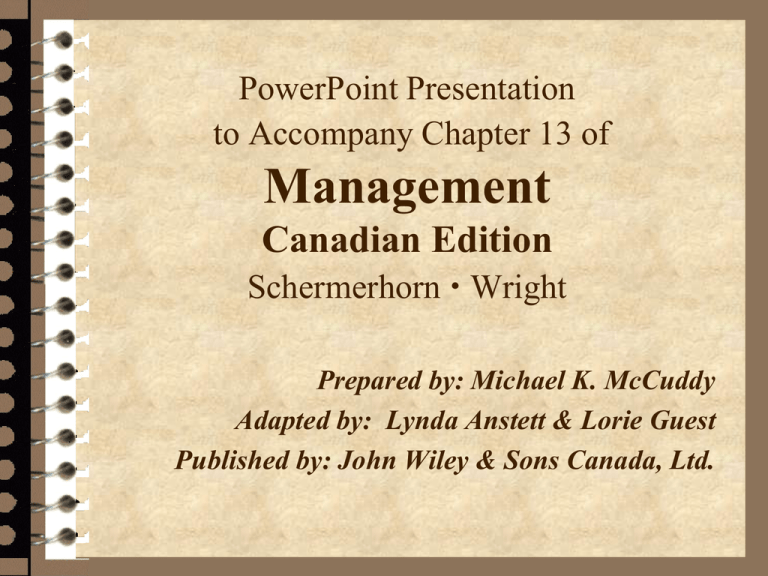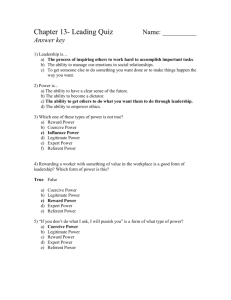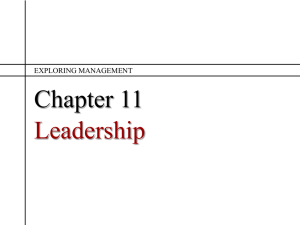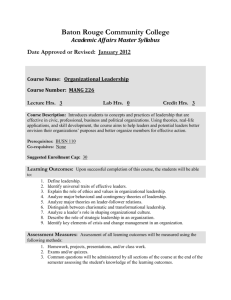
PowerPoint Presentation
to Accompany Chapter 13 of
Management
Canadian Edition
Schermerhorn Wright
Prepared by: Michael K. McCuddy
Adapted by: Lynda Anstett & Lorie Guest
Published by: John Wiley & Sons Canada, Ltd.
Planning Ahead — Chapter 13 Study Questions
What is the nature of leadership?
What are the important leadership traits and
behaviors?
What are the contingency theories of
leadership?
What is transformational leadership?
What are current issues in leadership
development?
Management - Chapter 13
2
Study Question 1: What is the nature
of leadership?
Leadership.
– The process of inspiring others to work hard to
accomplish important tasks.
Contemporary leadership challenges:
– Shorter time frames for accomplishing things.
– Expectations for success on the first attempt.
– Complex, ambiguous, and multidimensional problems.
– Taking a long-term view while meeting short-term
demands.
Management - Chapter 13
3
Study Question 1: What is the nature
of leadership?
Visionary leadership.
– Vision
• A future that one hopes to create or achieve in order
to improve upon the present state of affairs.
– Visionary leadership
• A leader who brings to the situation a clear and
compelling sense of the future as well as an
understanding of the actions needed to get there
successfully.
Management - Chapter 13
4
Study Question 1: What is the nature
of leadership?
Meeting the challenges of visionary
leadership:
– Challenge the process.
– Show enthusiasm.
– Help others to act.
– Set the example.
– Celebrate achievements.
Management - Chapter 13
5
Figure 13.1 Leading viewed in relationship
to the other management functions.
Management - Chapter 13
6
Study Question 1: What is the nature
of leadership?
Power.
– Ability to get someone else to do something you want
done or make things happen the way you want.
Power should be used to influence and control
others for the common good rather seeking to
exercise control for personal satisfaction.
Two sources of managerial power:
– Position power.
– Personal power.
Management - Chapter 13
7
Study Question 1: What is the nature
of leadership?
Position power.
– Based on a manager’s official status in the
organization’s hierarchy of authority.
Sources of position power:
– Reward power.
• Capability to offer something of value.
– Coercive power.
• Capability to punish or withhold positive outcomes.
– Legitimate power.
• Organizational position or status confers the right to control
those in subordinate positions.
Management - Chapter 13
8
Study Question 1: What is the nature
of leadership?
Personal power.
– Based on the unique personal qualities that a person
brings to the leadership situation.
Sources of personal power:
– Expert power.
• Capacity to influence others because of one’s knowledge and
skills.
– Referent power.
• Capacity to influence others because they admire you and want
to identify positively with you.
Management - Chapter 13
9
Figure 13.2 Sources of position power
and personal power used by managers.
Management - Chapter 13
10
Study Question 1: What is the nature
of leadership?
Turning power into influence …
– Successful leadership relies on acquiring and using all
sources of power.
– Use of reward power or legitimate power produces
temporary compliance.
– Use of coercive power produces, at best, temporary
compliance, often accompanied by resentment.
– Use of expert power or referent power has the most
enduring results and generates commitment.
Management - Chapter 13
11
Study Question 1: What is the nature
of leadership?
Keys to building managerial power:
– There is no substitute for expertise.
– Likable personal qualities are very important.
– Effort and hard work breed respect.
– Personal behavior must support expressed values.
Power and influence are affected by workplace
structures and networks:
– Centrality.
– Criticality.
– Visibility.
Management - Chapter 13
12
Study Question 1: What is the nature
of leadership?
Acceptance theory of authority.
– For a leader to achieve true influence, the other
person must:
• Truly understand the directive.
• Feel capable of carrying out the directive.
• Believe the directive is in the organization’s best
interests.
• Believe the directive is consistent with personal
values.
Management - Chapter 13
13
Study Question 1: What is the nature
of leadership?
Leadership and empowerment.
– Empowerment.
• The process through which managers enable and help others to
gain power and achieve influence.
– Effective leaders empower others by providing them
with:
•
•
•
•
Information.
Responsibility.
Authority.
Trust.
Management - Chapter 13
14
Study Question 1: What is the nature
of leadership?
How leaders can empower others:
– Involve others is selecting their work assignments and task
methods.
– Create an environment of cooperation, information sharing,
discussion, and shared ownership of goals.
– Encourage others to take initiative, make decisions, and use their
knowledge.
– Find out what others think and let them help design solutions.
– Give others the freedom to put their ideas and solutions into
practice.
– Recognize successes and encourage high performance.
Management - Chapter 13
15
Study Question 2: What are the important
leadership traits and behaviors?
Traits that are important for leadership success:
– Drive
– Self-confidence
– Creativity
– Cognitive ability
– Business knowledge
– Motivation
– Flexibility
– Honesty and integrity
Management - Chapter 13
16
Study Question 1: What is the nature
of leadership?
Leadership behavior …
– Leadership behavior theories focus on how leaders
behave when working with followers.
– Leadership styles are recurring patterns of behaviors
exhibited by leaders.
– Basic dimensions of leadership behaviors:
• Concern for the task to be accomplished.
• Concern for the people doing the work.
Management - Chapter 13
17
Study Question 2: What are the important
leadership traits and behaviors?
Task concerns
People concerns
– Plans and defines work to
be done.
– Assigns task
responsibilities.
– Sets clear work standards.
– Urges task completion.
– Monitors performance
results.
– Acts warm and supportive
toward followers.
– Develops social rapport
with followers.
– Respects the feelings of
followers.
– Is sensitive to followers’
needs.
– Shows trust in followers.
Management - Chapter 13
18
Study Question 2: What are the important
leadership traits and behaviors?
Blake and Mouton Leadership Grid
– Team management.
• High task concern; high people concern.
– Authority-obedience management.
• High task concern; low people concern.
– Country club management.
• High people concern; low task concern.
– Impoverished management.
• Low task concern; low people concern.
– Middle of the road management.
• Non-committal for both task concern and people concern.
Management - Chapter 13
19
Figure 13.3 Managerial styles in Blake
and Mouton’s Leadership Grid.
Management - Chapter 13
20
Study Question 2: What are the important
leadership traits and behaviors?
Classic leadership styles:
– Autocratic style.
• Emphasizes task over people, keeps authority and information
within the leader’s tight control, and acts in a unilateral
command-and-control fashion.
– Laissez-faire style.
• Shows little concern for task, lets the group make decisions,
and acts with a “do the best you can and don’t bother me”
attitude.
– Democratic style.
• Committed to task and people, getting things done while
sharing information, encouraging participation in decision
making, and helping people develop skills and competencies.
Management - Chapter 13
21
Study Question 3: What are the contingency
theories leadership?
Fiedler’s contingency model.
– Good leadership depends on a match between
leadership and situational demands.
– Determining leadership style:
• Low LPC task-motivated leaders.
• High LPC relationship-motivated leaders.
– Leadership is part of one’s personality, and therefore
relatively enduring and difficult to change.
– Leadership style must be fit to the situation.
Management - Chapter 13
22
Study Question 3: What are the contingency
theories leadership?
Fiedler’s contingency model (cont.).
– Diagnosing situational control:
• Quality of leader-member relations (good or poor).
• Degree of task structure (high or low).
• Amount of position power (strong or weak).
– Task oriented leaders are most successful in:
• Very favorable (high control) situations.
• Very unfavorable (low control) situations.
– Relationship-oriented leaders are most successful in:
• Situations of moderate control.
Management - Chapter 13
23
Figure 13.4 Matching leadership style
and situation: summary predictions from
Fiedler’s contingency theory.
Management - Chapter 13
24
Study Question 3: What are the contingency
theories leadership?
Hersey-Blanchard situational leadership
model.
– Leaders adjust their styles depending on the
readiness of their followers to perform in a
given situation.
• Readiness — how able, willing and confident
followers are in performing tasks.
Management - Chapter 13
25
Figure 13.5 Leadership implications of
the Hersey-Blanchard situational leadership
model.
Management - Chapter 13
26
Study Question 3: What are the contingency
theories leadership?
Hersey-Blanchard leadership styles:
– Delegating.
• Low-task, low-relationship style.
• Works best in high readiness-situations
– Participating.
• Low-task, high-relationship style.
• Works best in low- to moderate-readiness situations.
Management - Chapter 13
27
Study Question 3: What are the contingency
theories leadership?
Hersey-Blanchard leadership styles (cont.):
– Selling.
• High-task, high-relationship style.
• Work best in moderate- to high-readiness situations.
– Telling.
• High-task, low-relationship style.
• Work best in low-readiness situations.
Management - Chapter 13
28
Study Question 3: What are the contingency
theories leadership?
House’s path-goal leadership theory.
– Effective leadership deals with the paths
through which followers can achieve goals.
– Leadership styles for dealing with path-goal
relationships:
•
•
•
•
Directive leadership.
Supportive leadership.
Achievement-oriented leadership.
Participative leadership.
Management - Chapter 13
29
Figure 13.6 Contingency relationships in
the path-goal leadership theory.
Management - Chapter 13
30
Study Question 3: What are the contingency
theories leadership?
House’s leadership styles:
– Directive leadership.
•
•
•
•
•
Communicate expectations.
Give directions.
Schedule work.
Maintain performance standards.
Clarify leader’s role.
– Supportive leadership.
•
•
•
•
Make work pleasant.
Treat group members as equals.
Be friendly and approachable.
Show concern for subordinates’ well-being.
Management - Chapter 13
31
Study Question 3: What are the contingency
theories leadership?
House’s leadership styles:
– Achievement-oriented leadership.
•
•
•
•
Set challenging goals.
Expect high performance levels.
Emphasize continuous improvement.
Display confidence in meeting high standards.
– Participative leadership.
•
•
•
•
Involve subordinates in decision making.
Consult with subordinates.
Ask for subordinates’ suggestions.
Use subordinates’ suggestions.
Management - Chapter 13
32
Study Question 3: What are the contingency
theories leadership?
When to use House’s leadership styles:
– Use directive leadership when job assignments
are ambiguous.
– Use supportive leadership when worker selfconfidence is low.
– Use participative leadership when performance
incentives are poor.
– Use achievement-oriented leadership when task
challenge is insufficient.
Management - Chapter 13
33
Study Question 3: What are the contingency
theories leadership?
Substitutes for leadership.
– Aspects of the work setting and the people
involved that can reduce the need for a leader’s
personal involvement.
– Possible leadership substitutes:
• Subordinate characteristics.
• Task characteristics.
• Organizational characteristics.
Management - Chapter 13
34
Study Question 3: What are the contingency
theories leadership?
Vroom-Jago leader-participation theory.
– Helps leaders choose the method of decision
making that best fits the nature of the problem
situation.
– Basic decision-making choices:
• Authority decision.
• Consultative decision.
• Group decision.
Management - Chapter 13
35
Figure 13.7 Leadership implications of
Vroom-Jago leader-participation model.
Management - Chapter 13
36
Study Question 3: What are the contingency
theories leadership?
Decision-making options in the Vroom-
Jago leader-participation theory:
– Decide alone.
– Consult individually.
– Consult with group.
– Facilitate.
– Delegate.
Management - Chapter 13
37
Study Question 3: What are the contingency
theories leadership?
Contingency factors in the Vroom-Jago leader-
participation theory:
– Decision quality.
• Who has the information needed for problem solving.
– Decision acceptance.
• Importance of subordinate acceptance to eventual
implementation.
– Decision time.
• Time available to make and implement the decision.
Management - Chapter 13
38
Study Question 3: What are the contingency
theories leadership?
According to Vroom-Jago leader-participation
theory, a leader should use authority-oriented
decision methods when …
– The leader has greater expertise to solve a problem.
– The leader is confident and capable of acting alone.
– Others are likely to accept and implement the decision.
– Little or no time is available for discussion.
Management - Chapter 13
39
Study Question 3: What are the contingency
theories leadership?
According to Vroom-Jago leader-participation
theory, a leader should use group-oriented and
participative decision methods when …
– The leader lacks sufficient information to solve a
problem by himself/herself.
– The problem is unclear and help is needed to clarify the
situation.
– Acceptance of the decision and commitment by others
is necessary for implementation.
– Adequate time is available for true participation.
Management - Chapter 13
40
Study Question 4: What is transformational
leadership?
Benefits of participative decision methods:
– Help improve decision quality.
– Help improve decision acceptance.
– Helps develop leadership potential.
Potential disadvantages of participative decision
methods:
– Lost efficiency.
– Not particularly useful when problems must be solved
immediately.
Management - Chapter 13
41
Study Question 4: What is transformational
leadership?
Superleaders.
– Persons whose vision and strength of
personality have an extraordinary impact on
others.
Charismatic leaders.
– Develop special leader-follower relationships
and inspire others in extraordinary ways.
Management - Chapter 13
42
Study Question 4: What is transformational
leadership?
Transactional leadership.
– Someone who directs the efforts of others
through tasks, rewards, and structures
Transformational leadership.
– Someone who is truly inspirational as a leader
and who arouses others to seek extraordinary
performance accomplishments.
Management - Chapter 13
43
Study Question 4: What is transformational
leadership?
Characteristics of transformational leaders:
– Vision.
– Charisma.
– Symbolism.
– Empowerment.
– Intellectual stimulation.
– Integrity.
Management - Chapter 13
44
Study Question 5: What are current issues in
leadership development?
Emotional intelligence.
– The ability of people to manage themselves and
their relationships effectively.
– Components of emotional intelligence:
•
•
•
•
•
Self-awareness.
Self-regulation.
Motivation.
Empathy.
Social skill.
Management - Chapter 13
45
Study Question 5: What are current issues in
leadership development?
Gender and leadership.
– Both women and men can be effective leaders.
– Women tend to use interactive leadership.
• A style that shares qualities with transformational
leadership.
– Men tend to use transactional leadership.
– Interactive leadership provides a good fit with
the demands of a diverse workforce and the
new workplace.
Management - Chapter 13
46
Study Question 5: What are current issues in
leadership development?
Gender and leadership (cont.).
– Future leadership success will depend on a
person’s capacity to lead through :
•
•
•
•
Openness.
Positive relationships.
Support.
Empowerment.
Management - Chapter 13
47
Study Question 5: What are current issues in
leadership development?
Drucker’s “old-fashioned” leadership.
– Leadership is more than charisma; it is “good
old-fashioned” hard work.
– Essentials of “old-fashioned” leadership:
• Defining and establishing a sense of mission.
• Accepting leadership as a “responsibility” rather
than a rank.
• Earning and keeping the trust of others.
Management - Chapter 13
48
Study Question 5: What are current issues in
leadership development?
Moral leadership.
– Ethical leadership adheres to moral standards meeting
the test of “good” rather than “bad” and “right” rather
than “wrong.”
– All leaders are expected to maintain high ethical
standards.
– Long-term, sustainable success requires ethical
behavior.
– Integrity involves the leader’s honesty, credibility, and
consistency in putting values into action.
Management - Chapter 13
49
Study Question 5: What are current issues in
leadership development?
Moral leadership (cont.).
– Leaders with integrity earn the trust of their followers.
– Leaders have a moral obligation to build performance
capacities by awakening people’s potential.
– Authentic leadership activates performance through the
positive psychological states of confidence, hope,
optimism, and resilience.
– Authentic leadership helps in clearly framing and
responding to moral dilemmas, and serving as ethical
role models.
Management - Chapter 13
50
COPYRIGHT
Copyright © 2007 John Wiley & Sons Canada, Ltd. All rights
reserved. Reproduction or translation of this work beyond that
permitted by Access Copyright (The Canadian Copyright Licensing
Agency) is unlawful. Requests for further information should be
addressed to the Permissions Department, John Wiley & Sons
Canada, Ltd. The purchaser may make back-up copies for his or her
own use only and not for distribution or resale. The author and the
publisher assume no responsibility for errors, omissions, or damages
caused by the use of these programs or from the use of the
information contained herein.




